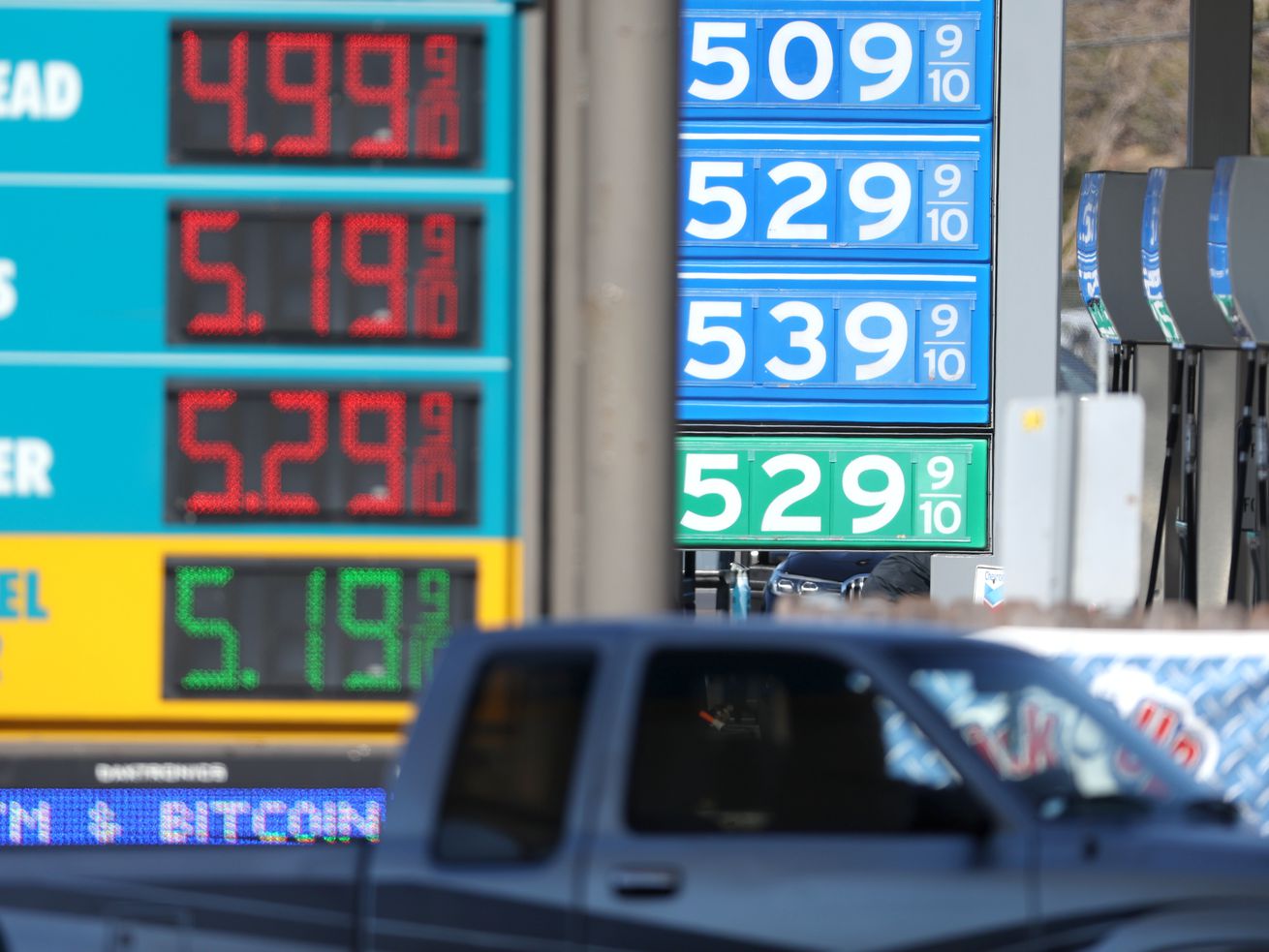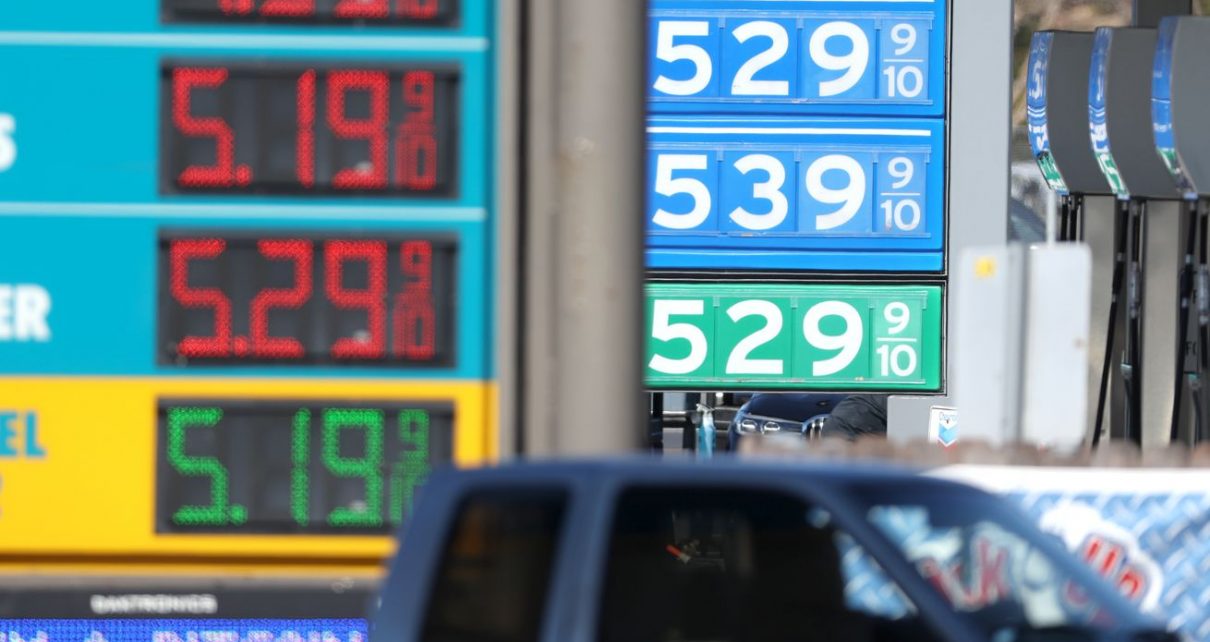
Summer driving season is going to suck.
The backdrop of global and domestic inflation in the United States was already worrying. Now, Russia’s invasion of Ukraine and the global reaction to it stand to make the situation worse — including sending gas prices soaring.
The conflict has roiled global markets, causing stock market turmoil, sending oil prices higher, and injecting even more uncertainty into an already off-balance worldwide economy. It’s also sparked concerns that inflation, already running hot, could run even hotter.
In the United States, the Consumer Price Index, which measures the average change in prices consumers pay for goods and services, was up by 7.5 percent over the past year in January. That’s a 40-year high. The hope was that inflation would soon start to come down, and that factors driving it, such as high gas prices and supply chain woes, would finally pass. Now, it appears that the situation could be quite the opposite.
“What we’re observing is essentially an energy price shock and a financial markets shock that comes on the back of this already concerning inflation environment, an environment in which global supply chains are already stressed and in which there is already some degree of uncertainty as to the outlook,” said Gregory Daco, chief economist at EY-Parthenon. “It’s not just a shock in isolation, it’s a shock in that context.”
Russia is one of the biggest oil and gas producers in the world, and any disruptions stand to have a major impact on prices — disruptions we’re already seeing. On Tuesday, President Joe Biden announced that the US would ban imports of Russian oil, natural gas, and coal. The United Kingdom has said it will scrap Russian oil imports as well. These maneuvers prompted a spike in oil prices, which have already been on the rise, and the situation is sure to have ripple effects across the global economy.
In early February, JPMorgan analysts projected that disruptions to oil flows from Russia could push oil prices to $120 per barrel, which, indeed, it already has. (For context, oil was priced in the $60 per barrel range a year ago, and started 2020 in the $70s and $80s.) Some analysts have warned that worst-case scenario oil prices could hit $200, and Russia has warned that $300 oil prices could be on the horizon, depending on what Europe, which is much more reliant on Russian oil and gas than the US, does.
In the US, Russian oil made up about 3 percent of shipments in 2021, according to Bloomberg, and when you include other petroleum products, that rises to 8 percent. That’s not a ton, but it’s not nothing, either. Major oil companies, such as Shell and BP, have said they’ll stop buying oil and gas from Russia and curb business with the country, which is causing volatility and prices changes as well. Europe is starting to move away from its dependence on Russia, too.
Americans — already dealing with high gas prices and annoyed at the rising costs of heating their homes — are in for a bumpy ride. Gas prices matter not just for people filling up the tanks of their cars but also because of shipping and transportation. The conflict could also translate to high diesel prices and jet fuel for airplanes. “The inflation machine is just not going to slow down,” said Patrick De Haan, head of petroleum analysis at GasBuddy.
According to AAA, the average price of gas nationally is $4.17 a gallon, up significantly from $2.66 a year ago. That number now stands to climb even higher, especially as the summer months approach, which will put more people on the road. As the New York Times points out, the last time gas prices were so high was during the 2008 financial crisis, when — adjusted for inflation — a gallon was priced at about $5.37.
Joe Brusuelas, chief economist at accounting and consulting firm RSM, told CNN in February that the Russia-Ukraine conflict could push inflation to 10 percent year over year, driven in part by gas. By his calculation, an increase in oil prices to $110 could increase consumer prices by 2.8 percent over the course of a year. Alan Detmeister, an economist at UBS, told the New York Times that oil at $120 per barrel could mean inflation at 9 percent in the coming months.
“It becomes a question of: How long do oil prices, natural gas wholesale prices stay elevated?” he told the Times. “That’s anybody’s guess.”
In remarks at the White House on Tuesday, President Biden acknowledged that the Russia-Ukraine conflict and measures the US and Europe have taken to push back against Russia will be felt domestically. “This decision today is not without cost here at home,” he said, referring to the Russian oil ban.
The Biden administration has promised to try to protect Americans from a spike in gas prices. Over the weekend, Secretary of State Anthony Blinken told CNN that the US is “talking to our European partners and allies to look in a coordinated way that prospect of banning the import of Russian oil while making sure that there’s still an appropriate supply of oil on world markets.”
Still, the options on oil supply are limited, at least in the immediate term. “The president has insinuated that he’s got it, he’s going to do everything he can,” said De Haan in February, but it’s not clear what other strings Biden can pull on. Striking a new nuclear deal with oil producer Iran could help, but it’s no silver bullet, nor is it clear it’s very likely to happen. “It’s no Russia, in terms of oil supply,” De Haan said. The US has also begun weighing whether it could look to Venezuela.
Higher oil prices could dampen on economic growth. People and companies having to spend more on oil and gas could reduce spending in other areas, and that could cut into GDP. By one estimate, a long-term increase in gas prices could cost the typical household in the US $2,000 per year.
There are other areas where the Russia-Ukraine conflict could show up in consumer prices. Russia is the largest wheat exporter in the world. As the Times notes, Russia and Ukraine make up 30 percent of global wheat exports, and Ukraine is also a major exporter of corn, barley, and vegetable oil. Disruptions to any of that could lead to disruptions in the commodities markets, therefore pushing up prices eventually at the grocery store. The conflict has caused wheat prices to surge. Bloomberg reported in February that the Biden administration isn’t yet going to impose sanctions on Russia that would impact aluminum, which would throw a wrench in the global supply, though aluminum and metal prices have already gone up.
“It’s a combination of a set of commodities that are being produced either in Ukraine or Russia that have been affected,” Daco said. He warned that if further sanctions are imposed on Russia, it could affect aluminum and commodities prices even more. “It’s a wide spectrum of agricultural, energy, and other commodities.” On Tuesday, Russian President Vladimir Putin signed a decree banning the exports of some commodities, which could have major global ramifications.
I took a brief moment from the news in the last hour … Big mistake.
This will have a dramatic impact on inflation, global value chains, growth and could cause a global recession. https://t.co/SP8YnMc9Q7
— Elina Ribakova (@elinaribakova) March 8, 2022
Reuters reported that the White House has warned the microchip industry about the possibility that Russia will curb access to some of the materials it sources from Ukraine and Russia and to look into diversifying the supply chain. A chip shortage and kinks in the semiconductor supply chain have contributed to higher prices and challenges across a number of industries, including cars and phones.
To be sure, there’s still plenty of uncertainty around what will happen in the Russia-Ukraine conflict and its economic consequences. Brusuelas told MarketWatch in February that the inflationary pressures depend “on the severity of sanctions and what happens on the ground.” The US and Europe have hit Russia with severe sanctions that will devastate the Russian economy and likely have a widespread impact on economic conditions around the world. In other words, economic uncertainty, including inflation, is probably not going away anytime soon.
In the United States, this will be a headache for the Federal Reserve, which is already on track to likely start to raise interest rates in an effort to combat inflation and otherwise roll back some supports for the economy.
“Energy prices mean that inflation is going to stay well above the Fed’s target in 2022, and that’s going to stiffen the Fed’s resolve to normalize monetary policy this year,” Bill Adams, chief economist for Comerica Bank, told Vox. “Inflation was drastically above the Fed’s target in 2021 and had looked like it was about to slow in 2022, but the surge in energy prices caused by the invasion is going to keep inflation higher for longer.”
Adams did, however, note that the US economy is quite strong at the moment, despite inflation. Jobs are coming back, and supply chain problems are being worked out.
“The big picture is that the US economy is strong and is well-positioned to absorb a shock like higher energy prices or disruptions to commodity supply from the Russia-Ukraine war,” he said. “We’re in a better position to absorb this shock than, for example, in 2006-2007 when energy prices were jumping but consumer balance sheets were much more stressed than they are today.”
Still, for Americans already navigating inflation, the current crisis is likely going to push prices up before they come down.
Update, March 8, 2022: This story was updated to include new economic developments stemming from the war in Ukraine.





